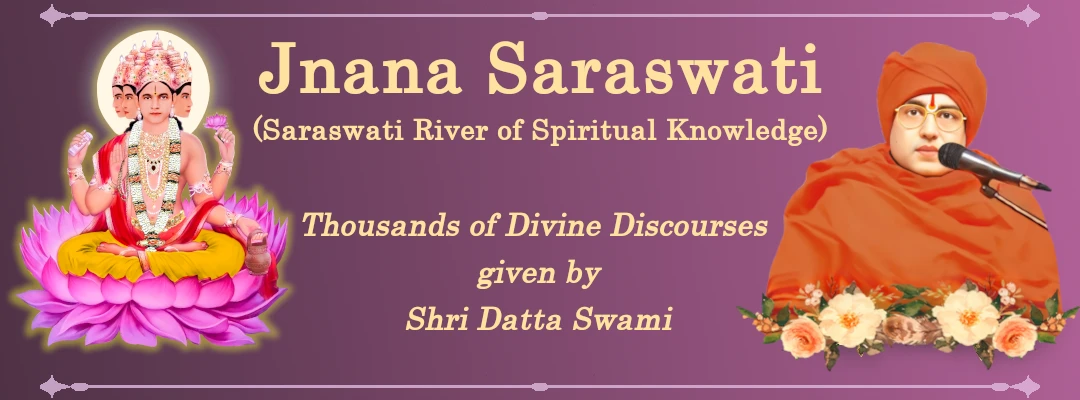
12 Nov 2019
Can we say that from the body point of view, we are servants of God, from the point of view of our individual soul, we are part of God and from the point of view of our soul, we are identical with God? [This question is part of a mahā satsaṅga or a great spiritual discussion between Swami and several devotees who had come from various places, seeking the clarification of their doubts.]
Swami replied: This statement was said by Hanumān to Rāma (Dehabuddhyātu dāso’ham, Jīvabuddhyā tvadaṃśakaḥ, Ātma buddhyā tvamevāham, iti me niścitā matiḥ.). But every soul is not Hanumān. Rāma was the Human Incarnation of God Nārāyaṇa and Hanumān is the Human Incarnation of God Sadāśiva. Both Nārāyaṇa and Sadāśiva are alternative names of the same God, known as Īśvara or Datta. Hence, both Rāma and Hanumān were the Incarnations of the same God. But the role of Rāma was to act as the Master and the role of Hanumān was to act as the servant of the Human Incarnation acting as the Master. Rāma never accepted that He was the Incarnation of God because His program was to act like an ideal human being. So, He hid His divinity completely from the public and only acted as Master with Hanumān. The role of Rāma was a double program. The first part was to act merely as an ideal human being before the general human world. The other part was to act as a Human Incarnation before Hanumān, so as to preach to human devotees how they should express spiritual devotion to a genuine Human Incarnation.
The program of Hanumān was to act like an ideal servant of the Human Incarnation. So, from the point of view of the external body (role), Hanumān said that He was the servant of Rāma. This dualism between the servant and God represents the dualistic philosophy of Madhva. If you take the individual soul of Rāma, on one hand, it was divine since He was a Human Incarnation of Nārāyaṇa. On the other hand, in terms of the role, Rāma was the Master. So, Rāma’s individual soul was the Whole. If we take the individual soul of Hanumān, on one hand, it is divine as Sadāśiva, but on the other hand, it was in the role of a servant. Thus, Hanumān’s soul becomes a part of the Whole. This Whole-part relation between God and the soul is like an intermediate policy. It is the philosophy of qualified monism given by Rāmānuja. If you take the soul of Rāma, which is Nārāyaṇa and the soul of Hanumān, which is Sadāśiva, both are one and the same Datta. Hence, at this innermost level, the monism of Śaṅkara is represented. Of course, the monism between Nārāyaṇa and Sadāśiva is due to the same unimaginable God existing in both. In fact, both Nārāyaṇa and Sadāśiva are alternative names of the same single Energetic Incarnation, Datta. The same Datta appears as Nārāyaṇa as well as Sadāśiva when viewed from two different angles. Datta entered another energetic form, called Brahmā. He entered another energetic form, called Viṣṇu and He entered yet another energetic form, called Śiva. So, Viṣṇu and Śiva are one and the same because the same Datta containing the same unimaginable God exists in both of them. Monism thus results whether you take Nārāyaṇa and Sadāśiva or you take Viṣṇu and Śiva.
Similarly, if you take the case of one ordinary human being who is the servant and another human being who is the master, the same relationship at the three levels can be seen. At the deepest level, the innermost soul of the two persons is one and the same. At the intermediate level, the individual souls of the two, having the feelings of master and servant, exhibit a whole-part relationship. At the external level, the bodies in the physical world exhibit the master-servant relationship. In this way, the above relationship between Rāma and Hanumān as well as the relationship between a human master and a human servant are exactly similar.
But the relationship between Rāma and an ordinary human being cannot have this type of relationship. Hence, an ordinary human being should not claim to have such a relationship with a genuine Human Incarnation. An ordinary human being should say to Rāma “From the three points of view of the innermost soul, the individual soul and the external body, I am your servant alone”. You cannot argue that the relative awareness of the human being-component of Rāma and the relative awareness of the ordinary human being are one and the same. Even though this is true in the basic sense, the relative awareness of the human being-component of Rāma has become the unimaginable God. The unimaginable God has permanently merged with Datta. So, the relative awareness of Datta contains the unimaginable God. When Datta merged with Rāma, Datta’s relative awareness, containing the unimaginable God, merged with the relative awareness of Rāma. Thereafter, Rāma’s relative awareness, no longer remained relative. It became the Absolute Awareness, which is not different from the unimaginable God. So, at every level, the total difference between the Human Incarnation of God and the ordinary human being is clearly maintained.
| Shri Dattaswami | Dehabuddhyaatu daasoham Jiivabuddhyaa tvadamshakah Aatma buddhyaa tvamevaaham iti me nishchitaa matih Ramanuja Narayana Shiva Vishnu Hanuman
★ ★ ★ ★ ★
Also Read
Why Is Every Soul Not God? Part-1
Posted on: 22/03/2021Why Is Every Soul Not God? Part-2
Posted on: 23/03/2021Why Is Every Soul Not God? Part-9
Posted on: 16/07/2021Why Is Every Soul Not God? Part-8
Posted on: 15/07/2021
Related Articles
Why Do People Worship Hanuman As God, When He Himself Worshipped Rama Like A Devotee?
Posted on: 01/11/2019God's Grace Is Greater Than His Vision
Posted on: 15/09/2019Is It The Will Of God Only That Hanuman Served As Servant Of God While Radha Entered Mad Devotion?
Posted on: 10/10/2021Datta Vedaantah - Brahmaparva: Chapter-3: Ishvaraavataara Jnanam
Posted on: 06/08/2021